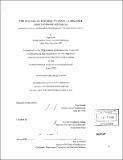The culture of building to craft--a regional contemporary aesthetic : material resources, technological innovations and the form making process
Author(s)
Nanda, Puja, 1971-
DownloadFull printable version (16.13Mb)
Other Contributors
Massachusetts Institute of Technology. Dept. of Architecture.
Advisor
Ann M. Pendleton-Jullian.
Terms of use
Metadata
Show full item recordAbstract
In the non-Western context, there always has been a dilemma between "who we are" and "who we should be" . One could say "between tradition and modernity" . When the alien culture of building was adopted, the ties with the traditional vernacular processes were snapped off without establishing a critical dialogue between the two. The prevalent primitive modes of production were incongruous with the concepts of mechanization . Moreover, the tradition of the craftsman as a master builder was replaced by the differentiation between the architectural practice, the building industry and the exiting crafts. This issue becomes even more complex in the present context, when the architectural practice and the building industry are subject to the global culture of commodification and homogenization . The architectural practices are churning out 'products' that appropriate the local idioms into universal themes without undergoing the 'process' of transformation and metamorphosis into a contemporary vocabulary. The industry, on the other hand, is assuming global references and has a thrust towards universal building materials and systems that ignore the regional resource base. In the kitsch that is generated, the 'regional identity' is lost . Left behind is historical mimicry, thematic interpretations and ethnic nostalgia. One cannot deny that the global culture of integration/homogenization is as much a reality as the local culture of differentiation/uniqueness. Critically looking at this intersection, this thesis states the issue again as: "What kind of a 'culture of building' would generate an 'aesthetic' that draws references from its regional context and is also true to contemporary? There are some alternate practices that sit at the intersection of local and universal aspirations. They achieve a design economy by emphasizing on the larger web of the extended natural patterns of the region . They respect the vernacular aesthetic where the building processes are composed essentially of relationships in time and place. Thus, their culture of building represents a 'process' that integrates the architectural practice with the local crafts and the existing building industry towards an aesthetic that is both regional and contemporary. This thesis represents an effort to formulate an alternative paradigm or a reference language to the current architectural practice in India, that is not subject to the global culture of commodification and homogenization but is rooted in its context. metamorphosis and transformation. This thesis argues that a bias towards the 'process' and not the 'product' has greater potential to render an aesthetic of the place.
Description
Thesis (S.M.)--Massachusetts Institute of Technology, Dept. of Architecture, 1999. Includes bibliographical references (p. 87-90).
Date issued
1999Department
Massachusetts Institute of Technology. Department of ArchitecturePublisher
Massachusetts Institute of Technology
Keywords
Architecture.